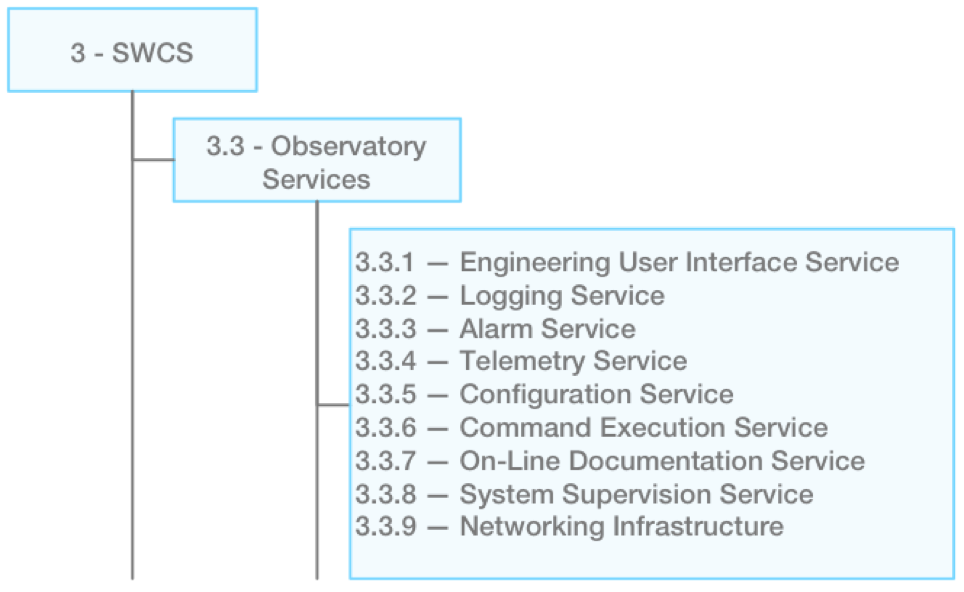6. Observatory Services#
The GMT software and controls system is highly distributed: the control components are deployed in computers distributed across different locations of the observatory and connected by networking infrastructure. This scheme makes it possible to optimize digital and analog signal paths, thermal conditioning, and maintenance accessibility.
A set of common services provides the basic infrastructure that enables the telescope control system (TCS) and observatory operations (OOP) components to communicate and collaborate in order to perform high-level control and monitoring. Additionally, some of these services have components that allow self-monitoring of their own operation. The Figure below shows the Observatory Services Product Tree:

Fig. 6.1 Observatory Services Product Tree#
The set of common services available to subsystems and components being controlled include:
Command Execution
Alarm events transport and management
Logging events transport
Telemetry sampling, transport and filtering
Component configuration
System health supervision
Engineering user interface
Command line access to all the registered components
Component and subsystem on line documentation (metadata)
Network infrastructure management
Data flow service (Low latency/ high bandwidth / synchronous)
Requirement |
Statement |
|---|---|
Communication Protocols |
The GMT shall define a standard set of software protocols and APIs that allow the communication with the required performance between different components. |
GMT System Health |
The GMT shall provide continuous performance, status and system health monitoring. |
Engineering Data System |
The GMT shall provide an engineering data system to monitor the health of all subsystems critical to the functioning and performance of the observatory. |
Diagnostic Software |
The GMT shall provide software tools for displaying real-time and long term trends in the performance of individual components/subsystems and to correlate that information with time-stamped data from other subsystems. |
Engineering Mode |
The GMT control software shall include an engineering mode that allows low-level control of components and subsystems. |
Integrated User Interface |
The GMT shall provide an integrated and consistent user interfaces. |
Telecommunications |
The GMT shall provide telecommunications between the facilities on the summit, the support site, the base facility, and connection to external commercial providers. |
Computer Network |
The GMT shall provide a computer network infrastructure on the summit to support telescope operation, the specified Operating Modes, required data transfer rates, and connection to the commercial provider. |
Requirement |
Statement |
|---|---|
Engineering Data System |
Provide an engineering data system to monitor the health of all subsystems critical to the functioning and performance of the observatory. |
Engineering Data Archive |
Provide an archive system that can be extended to store essential engineering data for the 50-year lifetime of the GMTO Observatory. |
Engineering Data Access |
Provide the capability to query and retrieve engineering data from all subsystems in a uniform way. |
Central Control Functions |
Provide central control capabilities for every control subsystem. |
Centralized Command Information and Execution |
Provide centralized, on-line, tools to inform, search, and execute, user commands and software components. |
Software Features Navigation |
Provide the capability to discover, navigate, and access efficiently, any feature provided by any software component. |
SWC Integrated User Interface |
Provide an integrated and consistent user interface. |
Data Bundle |
Provide a method to generate a data bundle that includes all raw and processed science and engineering data obtained during an observation. |
Local Safety and Status Information |
Provide status information for common operating states, alarm conditions, trip conditions, and corrective actions control system set point, and power supply status information that is required to operate the subsystem from the control room. |
Diagnosis Software |
Provide software tools for displaying real-time and long-term trends in the performance of individual components/subsystems and to correlate that information with time-stamped data from other subsystems. |